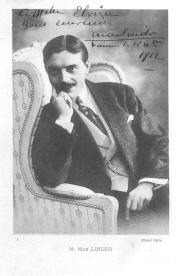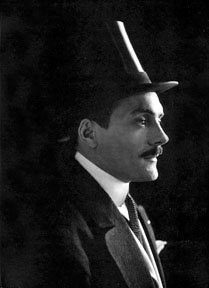| HOME | INDEX
French Film |
| HOME | INDEX
French Film |
| Max Linder
Pioneer of all movie comedians |
  Max
Linder differs from comedians at that time because of his style. Instead
of surface burlesque he does act without overacted mimic and launched the
comic from the movement. Like many other comedians in those days he also
was a highly gifted artist who carried out his stunts himself, e.g. his
dance on telephone wires high up. Linder was also endowed with a good portion
curiosity. So he insisted on learning the handling of a just now invented
seaplane and work it into one of his movies. He pursued several new kind
of sports and seized the opportunity to integrate individual scenes into
his movies. By it his movies became a kind of reflection of his time which
demonstrated the newest trend in the society. Max
Linder differs from comedians at that time because of his style. Instead
of surface burlesque he does act without overacted mimic and launched the
comic from the movement. Like many other comedians in those days he also
was a highly gifted artist who carried out his stunts himself, e.g. his
dance on telephone wires high up. Linder was also endowed with a good portion
curiosity. So he insisted on learning the handling of a just now invented
seaplane and work it into one of his movies. He pursued several new kind
of sports and seized the opportunity to integrate individual scenes into
his movies. By it his movies became a kind of reflection of his time which
demonstrated the newest trend in the society.
Max Linder, with his real name Gabriel Leuvielle, was born in Saint-Loubès
in 1883. His parents were winegrowers and as a child Max played hooky and
preferred to play between vines and together with the grape harvester.
As an adult he preferred to recover there from his stays in Moscow, Los
Angeles or Paris. His parents sent Max to a boarding school in Bordeaux,
but soon he also devoted his time more for other things than for school.
Sport was a field he was very interested in but especially the theater
could fascinate hime. Without the knowledge of his parents he enrolled
for a theater school. Then the tiring search for a job began. He played
to countless theater directors till got hearing at the theater Ambigu and
got a tiny part.
After André Deed went to Italy, Linder moved up to the comedy star No. 1 for Pathé. In 1910 he shot one comedy each week; they all revolved round the blameless bachelor Max who lives in luxury and gets into funny situations because he is after a well-behaved, pretty young lady. But soon the first of several bad illnesses interrupt Linder's activity and the audience became worried when the supply of new movies like "Max se marie - Max gets married" (1910) stopped. A cholera sickness in his childhood and a serious accident during shootings with a roller-skate interlude which nearly killed him and troubled him. In order to explain his absence to his audience Linder appeared in the documentary "Max dans sa famille" (1911) where he commented the reasons of his absence. However, shortly afterwards he came back in triumph and added his movies with a bow-tour through Europe. In 1914 he was world-famous and soon after he became his own producer who was able to sell his movies to Pathé like yard goods. His success didn't have any limits: whether Spain, Germany, Italy or Russia, Max Linder was everywhere welcomed with enthusiasm during his live entrances in the capital cities. In Russia the police had to call the Army for help so that Linder was able to leave the Moscow railroad station. By outbreak of World War I he volunteered as a soldier but came back
seriously fell ill after several months. Unfortunately he came into contact
with the notorious combat gas which gave him a physical hard time.
In 1916 he went to the USA where he was engaged by Essanay for eight movies as successor of Charles Chaplin. But only three were completed before Linder had to go back to Europa because of a pleurisy. For the convalescence he went to the idyllic lake of Geneva.
Max Linder fell in love with a seventeen year old girl in 1923 and they got married. At the same year he inaugurated his own Max-Linder cinema. He kept a special place in the building for the live orchestra because he always set great store by the musical background of his movies. Likewise in 1923 he shot the movie "Au secours? - Help!", co-written by Abel Gance. In this movie he played a tragic part; later he forbad the showing because he saw his reputation as a comedian in danger. His last finished movie - "Le roi du cirque - King of the Circus" (1924) - came into being in Vienna. For the movie "Der Ritter Barkas - The Knight Barkas" he contacted the in those days unknown director René Clair. But the destiny adopted a different method, the movie wasn't realized. Max Linder committed suicide on November 1st 1925 at the age of 42 after
he killed his wife. No one can understand today what the real reason for
this offence was - his morbid becoming jealousy or his poorer becoming
state of health.
Max Linder's influence on the development of the film comedy is recognized
by many people, among them no less a person than Charles Chaplin (whose
first movies point to a copy of the Max Linder figure).
I close this report with that dedication which Charles Chaplin wrote on a picture for his master: "For the unique Max, the great master - his student Charles Chaplin".
|